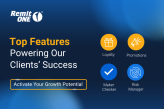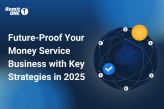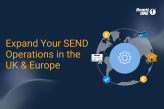Categories
Going Digital – How to go about it May 12, 2017

Going digital is one of the biggest things to hit the global remittance industry over the last few years. It’s a game changer for the existing players in the market and an opportunity for new entrants to take advantage of the digital age. Adopting the digital model is not as easy as it sounds, there are organisational, process and technical considerations – let alone branding, agents and wider partnerships to consider. There are some key learnings which we will explore here.
‘Going digital’ can mean different things to different remittance providers, with different motivations for doing so. Some MTOs see it as an additional channel to their existing agent or branch based network, others see it as a model which will allow them to revamp their existing channels and reduce their cost base. Newcomers see it as an enabler which allows gives them an instant place in their chosen market without the need for significant infrastructure.
For some it means an online presence, or a smartphone app, or both (or where smartphones are less common, an app for the good old feature phone). For others it might just mean providing capabilities to accept digital payments.
In many markets, consumers are driving the move to digital – being tech savvy often means they prefer to deal with you via an app or a website. They trust digital to be the quickest, most secure and cheapest way to send remittances. Increasingly they will expect flexibility, promotions and loyalty programs. The tech savvy consumer expects to be able to do everything with you online or via an app and will express frustration when that is not possible. This need can only increase as more and more ‘Generation Z’, aka post-Millennials, arrive in the workforce.
Regulators see going digital as a way of regulating the massive market that is currently unregulated. Banks also see digital payments as being transparent and traceable, thereby increasing auditability and lowering their risk.
All good then, except for one thing. How to go about it? What are the key learnings?
- Start with the End in mind
It might seem obvious to state it, but start with the end in mind. If you start off down a route that can give you some elements of digital but not the full offering you had in mind then you may end up needing to start from scratch at some point in the near future.So, map out your ideal end position if you can and consider the best plan to get there, staged or otherwise. For some MTO’s this might be the right time to tackle the core remittance technology platform. A digital offering is only as good as the technology providing it. Adding digital capabilities on top of a platform that wasn’t designed for it will catch up with you sooner or later.This might seem like a daunting prospect but going digital might be the ideal business case to help you justify a technology platform change. A fully hosted cloud based Software as a Service platform can make the migration easier and can allow you to run services in parallel if you have a large data migration to undertake.
- Choose an End to End vendor
Technology vendors often work in silos. They like to focus on their individual capability, leaving the integration work to you. By choosing an end to end provider you can take advantage of the relationships that such a provider already has in place and the integrations they have already made work.An end to end provider should have a broad capability to support your transition; consulting, technology, hosted platforms, integrations, plus a network of specialists and partners for you to work with. A decent end to end vendor will provide advice, guidance and support all the way through the process as well as introduce you to an umbrella of relationships that will be valuable to your remittance business.There’s no substitute for experience, so when embarking on a digital project you should choose an end to end vendor that has significant previous experience of supporting their clients through similar implementations. As well as having the right range of services they should bring good project skills to keep you on track.
- Help your agent network go digital
If you are an existing MTO with an agent network, you will want to consider what your digital offering will do for them. There is a good potential for agents to gain from moving to a digital model by investing in technology on their behalf and diversifying their offering. This will make it easier for them to bring in new customers while also still being able to service the old.In our published paper ‘Does digital mean the end of money transfer agents’ (February 2017), we explored how digital technology can revitalise the MTO/agent relationship. We showed how it can be used as a way of fostering agent loyalty and as a way of ensuring there is still enough margin in the transaction to support the agent network. In many remittance models it is still the agent that holds the relationship with the remitter. We highlighted that there are technologies available which you can provide to your agent network to make them digital and increase the amount of business they do with you.
- Adopt a Payment Service Provider (PSP)
The blurring of the lines between Remittance and Payments industries could offer quicker, more transparent and compliant transactions that could lead to lower charges and more money going to the beneficiaries.Tapping into the payments market provides the money transfer industry with more ways of getting funds from A to B. It also provides an opportunity to by-pass the middle layer of financial settlement.We explored this theme in our paper ‘Three major trends in Money Transfer for you to manage’ (March 2017).
We summarised it as follows: using a payment gateway/acquirer service rather than the traditional banking network infrastructure has three key potential benefits:
i) It can potentially lower the overall transaction cost because it takes out one or more steps in the transaction flow process.
ii) It can mean that an MTO can operate without the need to have a money service business account – and we know that as the banks are de-risking, gaining and maintaining a money service business account can be difficult for the smaller MTOs.
iii) It will ensure transparent, compliant and secure transactions offering convenience to customers and allowing unbanked people around the world to have access to certain financial services.
Our own PSP offering, PayTree™, provides digital payments for online and agents alike. We see this as an important aspect of digital; i.e. the ability to work seamlessly across multiple channels to avoid duplication of integration effort and to drive the best price/performance. Our digital Know Your Customer (KYC) offering has the same ability to work across multiple delivery platforms to ensure an integrated digital and non-digital experience.
Adopting a PSP might not immediately reduce transaction costs, but it does give you greater control, offers straight through processing and eliminates the need for a money service business bank account. It does have the potential to give you better rates as your transaction volumes grow because there are fewer suppliers in the payment chain which generally leads to more competitive rates.
- Where to go for help
A modern platform can help you to go digital as well as helping you to take advantage of alternative payment options.But that’s only part of the story. As an end-to-end provider we understand the need to look at the market in its entirety and to offer products & services that; a). help new money transfer providers at every step of the way towards launch, and b). help existing providers to manage change that can affect their particular trading corridors at any time.Our clients have adopted digital for different reasons. Some because they wanted to add value to their existing business model, others because they wanted a digital only go-to-market strategy for a particular corridor. We even have clients who were forced by their regulators to introduce digital. These experiences add further insight into what it means to go digital. We look forward to sharing our client stories with you. Come and talk to us: www.remitone.com
Related Posts
-

Power Up Your Platform: The Top RemitONE Features Driving Our Clients’ Success
What if the growth you’re chasing is already built into your system? If you’re using the RemitONE Money Transfer Platform,…
July 9, 2025 -

Episode 1: Trump’s Threats to Cross-Border Payments – What It Means for Your Money Service Business
Donald Trump’s return to office has reignited policy debates, with ripple effects already reaching the cross-border payments space. From remittance…
July 9, 2025 -

How to Build a Leaner, Smarter Money Service Business in 2025
In an era of rapid regulatory change, rising customer expectations, and digital disruption, how can money service businesses (MSBs)—companies that…
May 22, 2025 -

Trump’s Threats to Cross-Border Payments: What It Means for Your Business
It’s been a short while since Trump stormed back into office, and he’s already shaken things up with his hard-hitting…
May 22, 2025 -

Unlock Faster, More Secure Payments with RemitONE’s Open Banking Solution
We’re excited to introduce the latest enhancement to our RemitONE Money Transfer Platform: the RemitONE Open Banking Solution. Competitively priced…
January 31, 2025 -

How to Expand Your SEND Operations in the UK and Europe—Without the Regulatory Hassle
The remittance market in Europe is valued at €133.7 billion annually, with the UK market contributing an additional £23 billion.
January 31, 2025